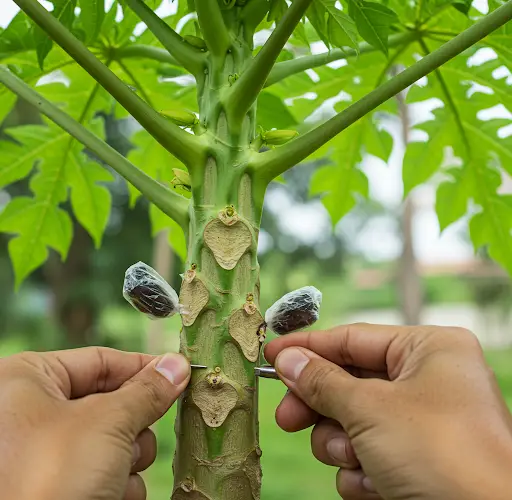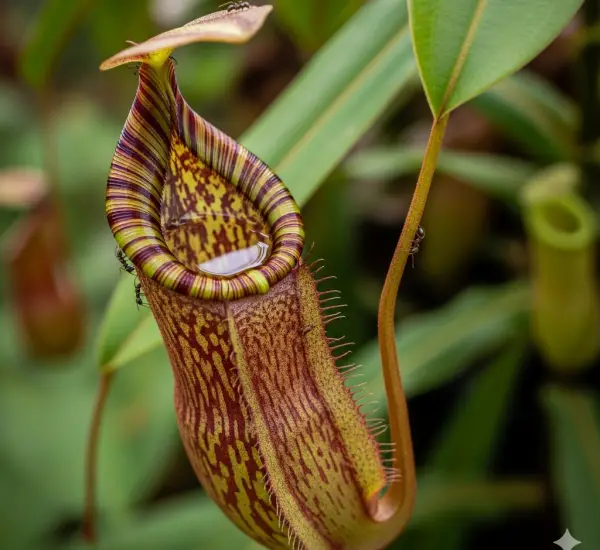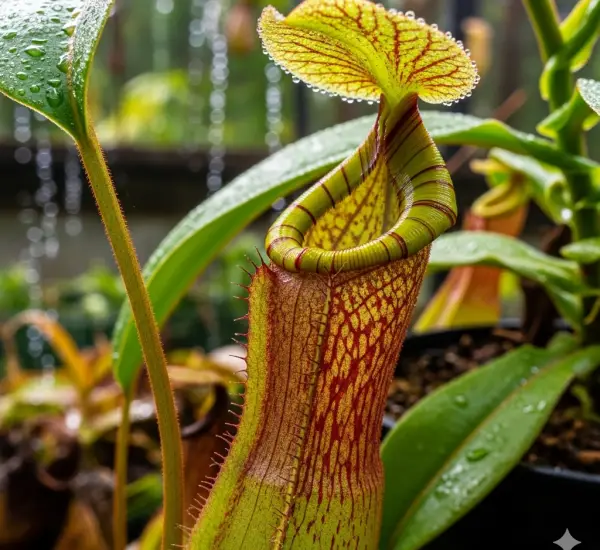How to Propagate and Graft Papaya Trees to Produce Large Fruits
Papaya (Carica papaya) is a fast-growing tropical fruit tree known for its delicious, nutrient-rich fruits. While papaya trees can be grown from seeds, propagating them through grafting significantly improves fruit quality, yield, and disease resistance. Grafting allows you to combine the best traits of different papaya varieties, ensuring larger, tastier, and more consistent fruit production. This guide will walk you through the step-by-step process of propagating and grafting papaya trees to achieve superior fruit quality.
Benefits of Propagating and Grafting Papaya Trees
- Improved Fruit Quality – Grafted papaya trees produce larger, sweeter, and more uniform fruits.
- Disease Resistance – Grafting onto disease-resistant rootstocks helps protect against soil-borne diseases and pests.
- Faster Fruit Production – Grafted papayas mature and bear fruit earlier than seed-grown trees.
- Controlled Plant Characteristics – You can select rootstocks and scions with the desired traits, such as higher productivity and strong root systems.
- Higher Yield – Grafted trees tend to produce more fruit due to improved genetic traits.
How to Propagate Papaya Trees from Seeds
Step 1: Selecting Quality Seeds
To grow strong and healthy rootstocks for grafting, start by selecting high-quality papaya seeds from a reliable source. Choose seeds from large, healthy, and high-yielding trees to ensure good genetic traits.
Step 2: Seed Preparation and Germination
- Extract seeds from a ripe papaya and wash off any pulp.
- Soak the seeds in warm water for 24 hours to soften the seed coat and improve germination.
- Spread the seeds on a paper towel and let them dry for a few hours.
- Plant the seeds in seed trays or small pots filled with well-draining soil or a mixture of sand and compost.
- Keep the soil moist but not waterlogged, and place the trays in a warm, shaded area.
- Germination takes about 1-3 weeks. Once seedlings have developed 3-4 true leaves, they are ready for grafting.
How to Graft Papaya Trees for Large Fruits
Grafting is a technique that involves joining two plant parts—the rootstock and the scion—to create a single, improved tree. The rootstock provides a strong foundation, while the scion comes from a high-yielding tree known for producing large fruits.
Step 1: Choosing the Right Rootstock and Scion
- The rootstock should be a healthy, disease-resistant seedling about 3-4 months old with a stem diameter of at least ½ inch.
- The scion should be taken from a mature, high-yielding papaya tree that produces large and sweet fruits.
Step 2: Preparing the Rootstock
- Using a sharp, sterilized knife or grafting blade, make a clean horizontal cut about 4-6 inches above the soil level.
- Make a vertical slit (about 1 inch deep) in the center of the cut rootstock to prepare it for the scion.
Step 3: Preparing the Scion
- Select a healthy branch from the desired papaya variety with at least two nodes.
- Cut the scion into a wedge shape at the base so that it fits into the slit on the rootstock.
Step 4: Grafting the Scion onto the Rootstock
- Insert the scion’s wedge-shaped cut into the rootstock’s vertical slit.
- Ensure the cambium layers (inner greenish layer of the bark) of both parts align to promote fusion.
- Wrap the grafted area with grafting tape, a rubber band, or plastic film to secure the connection and prevent moisture loss.
- Place the grafted plant in a shaded, humid area to allow healing.
Step 5: Post-Grafting Care
- Water the grafted plant lightly and keep the soil moist but not soggy.
- Avoid direct sunlight for the first two weeks to prevent dehydration.
- After 3-4 weeks, once the scion starts showing new growth, carefully remove the grafting tape.
- Gradually expose the plant to more sunlight as it strengthens.
Caring for Grafted Papaya Trees for Maximum Fruit Production
1. Soil and Fertilization
- Use well-draining soil rich in organic matter.
- Apply a balanced fertilizer (NPK 10-10-10) every 3-4 weeks to support growth.
- Boost flowering and fruiting with potassium-rich fertilizers.
2. Watering
- Water the tree regularly, especially during dry periods, but avoid overwatering.
- Ensure good drainage to prevent root rot.
3. Pruning and Maintenance
- Remove any side shoots or suckers that grow below the graft union.
- Trim weak or diseased branches to encourage healthy growth.
4. Pest and Disease Management
- Inspect trees regularly for pests like aphids, spider mites, and fruit flies.
- Use organic insecticides or neem oil to control pests.
- Prevent fungal infections by ensuring good air circulation and avoiding excessive moisture.
5. Supporting the Tree
- Papaya trees have shallow roots and can be fragile. Stake young trees to prevent them from bending or breaking.
Harvesting Large Papayas
Grafted papaya trees usually start producing fruit within 6-9 months, earlier than seed-grown trees.
- Harvest fruits when they begin to change color from green to yellow-orange.
- Pick them gently to avoid bruising and allow them to ripen at room temperature.
Conclusion
Grafting papaya trees is an effective way to ensure high-quality fruit production with better disease resistance and faster growth. By selecting the right rootstock and scion, following proper grafting techniques, and providing good care, you can successfully grow papaya trees that yield large, delicious fruits. Whether you’re a backyard gardener or looking to start a small papaya farm, grafting is an excellent technique to enhance fruit quality and productivity. Start your grafting journey today and enjoy an abundant harvest of homegrown papayas!



